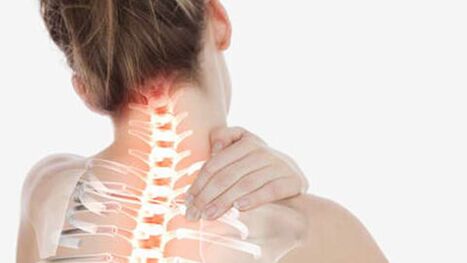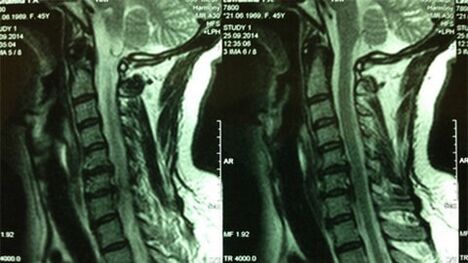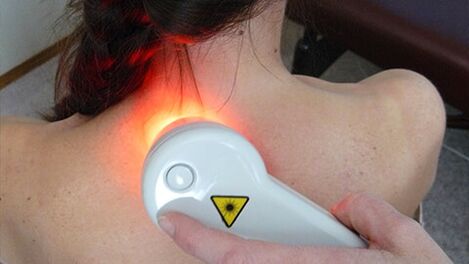
The cervical osteochondrosis is a progressive degenerative-dystrophic process that leads to exhaustion, deformation and destruction of the intervertebral discs of the cervix region.The loss of the shock absorbing cartilage causes pain both due to the exposure of the articular surfaces (spondylarthrosis) and due to the refinement of the nerve roots of the spinal cord.
In the absence of timely treatment, it is possible to kill the spine with the loss of its natural flexibility, the blood supply to the brain, the deterioration of the nervous line in these parts of the body that impress the roots of the cervical spine.
The pathology can develop both independently and as part of a general damage to the spine with covering the parts of the breast, lumbar and sacral parts.
General information
It is believed that the osteochondrosis of the cervical spine is more common than in other departments.In fact, this is not the case - dystrophic phenomena develop evenly at all points of the maximum load in the area of the main lane of the spine (the lower the department is, the greater the load that it bears).However, the symptoms of cervical osteochondrosis are more pronounced and seem to be more common.This is due to the high mobility of the vertebrae of the neck, which at the same time keep the head and peculiarity of the exits of the rotating roots of the spinal cord.
Note!According to statistics, the disease affects more than 60% of medium and older people.However, a rejuvenation of the pathological process has recently been observed - pathology can be found in young people and even young people.This is due to the generalization of studies and work as well as a reduction in physical activity and a deterioration in nutritional quality.
In view of the age of age, 2 forms of cervical osteochondrosis can be distinguished - physiologically and pathological.
Physiological processIt is associated with the natural aging of the body if the symptoms of the disease are a result of the gradual wear of the intervertebral discs.The process takes place under the influence of the endocrine system and is a consequence of menopause.The destruction of the cartilage structures begins from the center of the intervertebral disc and is accompanied by a gradual replacement of the cartilage tissue of the fiber.Pathology is irreversible, but can be compensated for by special medications.
Pathological processIt is associated with abnormal destructive changes in the body - immune, dystrophic, inflammatory and metabolic.First, subcutaneous tissues are involved in salts of salts of bone structures, nerve roots are inflamed, atrophy or skeletal muscle hypertonity occur, which leads to circulatory disorders in the head and combination.The pathology is treated in timely diagnosis and ends with the complete restoration of the healthy function of organs and tissues.
Stages of cervical osteochondrosis and their symptoms
There are 4 main stages of the pathological process:
- 1. Level is expressed by slight symptoms and muscles in the diseased region, cartilage slices lose their stability.
- 2nd level of local pain occurs especially in the case of head movements.The intervertebral discs are deformed, the fiber ring begins to collapse, the distance between the vertebrae is reduced;
- 3. Stage and pain increases and becomes constant, the movement is limited.The heads of the head can cause dizziness, nausea, a violation of blood supply to the brain, leads to general lethargy, fast tiredness, impairment of the concentration, the cartilage tissue is thin, the vertebrae is closed, the fiber -effective ring is completely destroyed with the emergence of the intermediate braler.
- The 4th stage of the pain syndrome fully immobilizes the neck area, the blood circulation of the brain is disturbed and requires constant support for the drugs, the vertebrae begin to grow together.
Cervical osteochondrosis: signs, symptoms of pathology
In the first stages, osteochondrosis is asymptomatic.While the disease develops, a characteristic feature is the presence of painful or unpleasant sensations in the head, neck and chest, less often in the upper limbs.
All possible symptoms can be assigned to 4 types of syndromes: cardiac, vertebral, roying (nervous) and spinal arteries syndrome (with circulatory disorders).
Vertack syndrome:
- Crunch in the neck when turning/heading the heads;
- With the progress of the disease, the pain and difficulties of the movement occur;
- Morphological diseases of the structure in the body of the vertebra and intervertebral space (visible on the X -Ray).
Heart syndrome:
- Shortness, weakness;
- A feeling of incomplete breath, lack of air;
- Spontaneous phenomena from the cardiovascular system angina pectoris, rag pain, burning;
Rook syndrome:
- Doubleness of the tongue, shoulders, fingers, background region;
- Difficulty swallowing;
- Unpleasant sensations in the area between the shoulder blades;
- Headache in the neck and forehead.
Vail arteries syndrome:
- inappropriate blood pressure jump;
- Dizziness, until the loss of consciousness;
- Noise in the ears, a feeling of cotton wool in the head;
- temporary blindness, "flies" into the eyes;
- Regular nausea attacks, especially when the transition;
- Headache - mainly in the neck and migraines;
- Sleepiness, performance, memory, attention concentration, depression.
Attention!All of these syndromes should be combined.The lack of symptoms of one of them can be a reason for the differential diagnosis with other disease groups.
The causes of cervical osteochondrosis
Dostrophic phenomena in the cervical spine are associated with the vertical position of the skeleton and the specific distribution of static and dynamic loads, which largely depend on the prevailing poses and the degree of development of skeletal muscles.
The main reasons:
- The lack of movement - which does not develop - worsens: the muscles weaken, the tissue are destroyed;
- Wrong static poses - muscle terminals lead to circulatory disorders with subsequent tissue dystrophy;
- A lack of nutrition or unbalanced nutrition - the body should receive everything that is necessary for the construction and renewal of bone and cartilage structures of the skeleton, whereby the muscle tone is maintained.
- Overweight obesity, weights - the load of the structure of the skeleton increases;
- constant nervous tension and nervous loads;
- Handling of the cervix region - "trapped", "inflated" - provokes hidden inflammatory processes;
- The presence of autoimmune diseases with cartilaginous tissue leads to its premature destruction.
- Endocrine pathologies are confused by the mineral metabolism, reduce the digestibility of calcium, silicon, phosphorus and other elements of the bone chryshot tissue;
- Injuries to the cervix region;
- Congenital anomalies of the spine and the adjacent muscles.
Diagnosis

The diagnosis "osteochondrosis of the cervical vertebra" consists of the low specificity of the symptoms and a variety of their manifestations.In the examination process, a consultation of a neurologist, surgeon, orthopedic surgeon and cardiologist is required.
A physical examination is carried out by a doctor with a patient survey.The most important diagnostic load is in instrumental and laboratory research methods.
Instrumental diagnostics:
- X -Ray of the cervix department;In the initial phase of the process, the MRI of the cervical department will be more informative - it will ensure a high visualization of solid and soft tissue - shows the condition of the intervertebral discs, the presence of osteophytes, deformations, damage to the nerve roots and blood vessels;evaluates the condition of the ligaments, muscles, bone tissue;
- Ultrasound shows the dynamic state of the soft tissue;
- Dopplerography of the neck vessels will help to evaluate the hemodynamics and the degree of damage to the blood vessels (in particular the condition of the vertebral artery).
- Contrast myelography - helps to suspect violations of nerve processes;
- The EKG and the echocardiography of the heart are used to diagnose the differential diagnosis of heart syndrome with heart cycle.
How to treat cervical osteochondrosis
The complex of medical measures is formed taking into account the stage of the disease (acute, chronic), the degree of damage and the causes of the development of pathology.Use conservative treatment, surgical intervention, mixed approach.
Conservative effect
It is a gradual restoration or compensation for damage to the background of symptomatic treatment.Contains drug therapy, physiotherapy, training therapy and massage methods.
Drug treatment:
- Pain relievers - mainly gels and ointments of local influence;In severe cases - frequent pain relievers in the form of tablets;
- anti -inflammatory medication - NSAIDS and corticosteroids (if necessary short course);
- Medicines to improve microcirculation and blood circulation in general;
- Chondroprotectors - means of protection and restoring cartilage tissue;
- Musorelaxants - eliminate muscle clamps and cramps;
- Vitamin and micro-complexes are required for the nutrition and support of fabrics by components.
When the acute symptoms are weakened, the methods of physiotherapy, training therapy and self -massage are connected.
Therapeutic gymnasticsImproves the nutrition of cartilage and bone tissues by restoring blood supply in the damaged area.To avoid complications, it is recommended to use the method of using isometric movements if you use your imitation instead of real curves and inclination of the head that can harm.
Attention!All measures should only be carried out with a doctor after the diagnosis and consultation.
The technology enables you to develop and strengthen atrophied short neck muscles and to stabilize the position of the cervical spine.The sequence of the basic exercises:
- The hand surface of the right hand is reduced to the side surface of the head press on your head within 10 seconds, while the muscles of head and neck are tense-and the head should remain motionless.
- Sink your hand, relax the muscles of the head and neck as far as possible for 20 seconds.
- Repeat the exercise with your left hand.
- Get both hands with your palms on the forehead with your palms in the forehead for both seconds, as if you were trying to reject your head while trying to resist your neck muscles to resist the movement.The head should remain motionless.
- Select your hands and relax your muscles similar to the previous exercise.
- Place both palms in the area over the back of the head.Through analogy, they perform the muscles of the neck and try to tilt your head forward - it should still be motionless.
- Sink your hands, relax your neck and head muscles.Repeat the set of exercises 4-10 times.
After strengthening the short neck muscles, you can carry out dynamic exercises.
Note!Swimming and water aerobics have proven well as a methodology for restoring the mobility of the cervix region.
Self -massageAllows you to reduce the intensity of local reactions and to remove muscle clamps during the static work.Rules for execution:
- Exposition range - background of the head, back and side surfaces of the neck;
- Perform the procedure in a seated position;
- Movements should be carried out in the direction of the spine;
- Use only fingertips;
- Avoid pressure on inflamed areas;
- Perform movements smoothly - sharp pressure can damage.

PhysiotherapyCharacteristic of inpatient treatment and sanatorium resort rehabilitation.Proven well:
- Electrophoresis - hears the zone, improves microcirculation, is used to deeper penetrating local drugs.
- Magnetotherapy;
- Amplipulse;
- Uhf.
Surgical intervention is indicated by complicated extrusion, violations of the spinal cord and unconscious pain syndromes.
As a cervical osteochondrosis, it is dangerous
The neck area focuses on the dense interweaving of the main blood vessels, nervous processes and the dynamic structures of the bone skeleton.In the absence of treatment, serious pathological changes can be observed:
- The weakening of the fibrous ring causes transfers and subluxation in the area of the mobest vertebrae;
- The presence of osteophytes and the spasmung of muscles leads to a violation of nerve roots and blood vessels with the formation of compression syndromes;
- The destruction of the cartilaginous slices and the rapprochement of the vertebrae leads to intervertebral disc hernia with violations of the nerve tissue.
Each of this phenomenon follows a pronounced negative reaction of the entire organism.
Possible complications and consequences
The list of the most common complications of cervical osteochondrosis can be included:
- Vegetovascular dystonia;
- Hypertension;
- Oxygen hunger of the brain and its structures;
- Dystrophy of the eye skin with visual impairment;
- Thyroid failure;
- Disorder of the functions of the esophagus and the trachea - difficulties in swallowing and breathing cramps;
- unconscious pain syndrome in the head, neck, chest, upper extremities;
- Cramps and numbness of the face, hands;
- Disruptions of the hypothalamic -heighted system that creates a failure of the body's entire hormonal activity.
Preventive measures
The most effective treatment is the prevention of the disease.Prevention will help you.It is sufficient to follow several basic recommendations:
- Adjust your attitude
- create a comfortable workplace;
- Take breaks in "physical education" during the sitting work.
- Add into your food foods that rich in calcium, magnesium, phosphorus, silicon - fish, nuts, seeds, legumes, dairy products, fresh vegetables, fruit;Limit the consumption of salt, sweet, flour and sharp dishes;
- Use orthopedic mattress and pillows for sleep and calm;
- Take care of a not populated sport - it is better to prefer swimming.
Even if you cannot take all requirements into account, moderate physical exertion, adequate nutrition and attentive attitude to your attitude can significantly reduce the risk of a pathology.





































